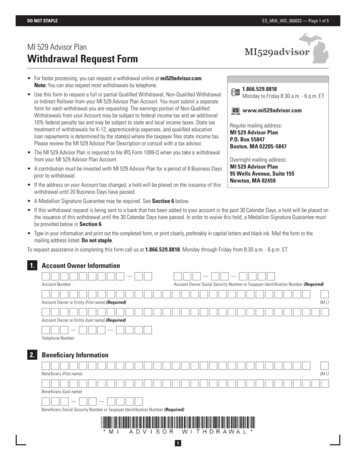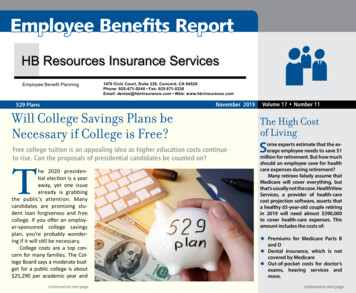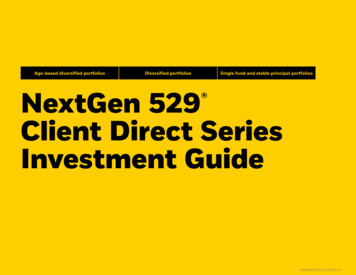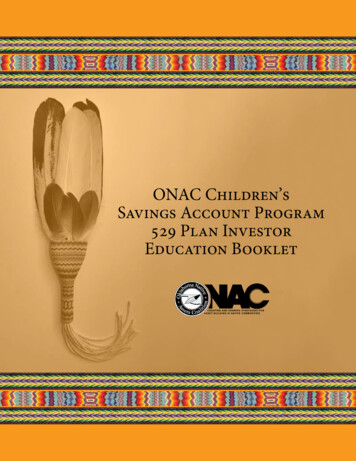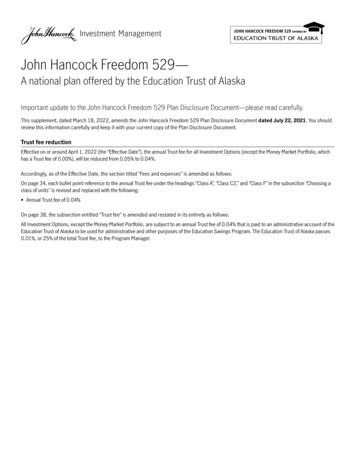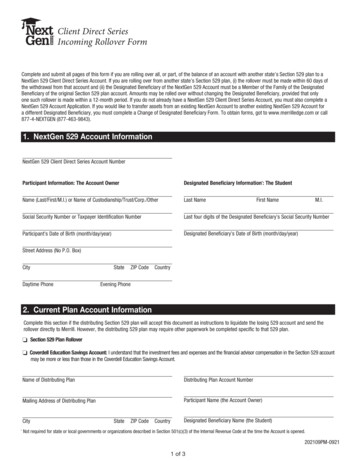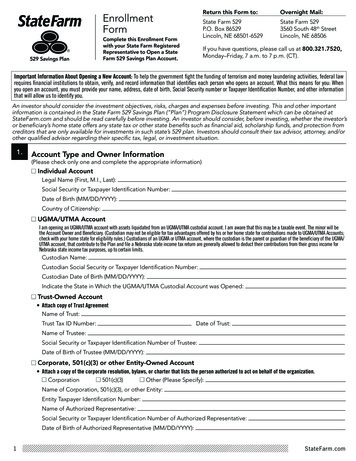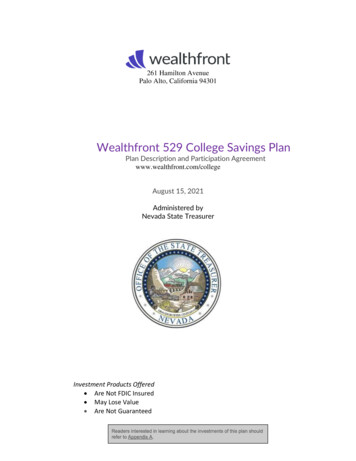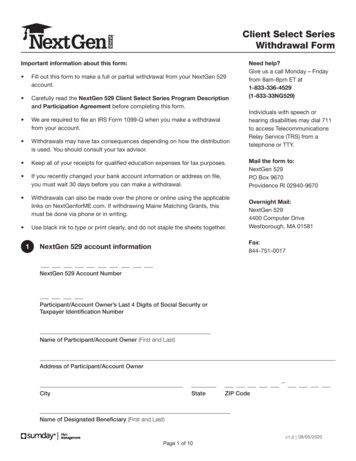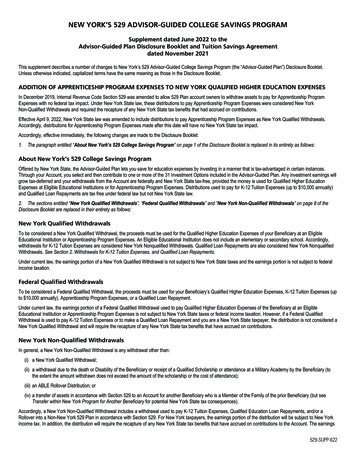
Transcription
NEW YORK’S 529 ADVISOR-GUIDED COLLEGE SAVINGS PROGRAMSupplement dated June 2022 to theAdvisor-Guided Plan Disclosure Booklet and Tuition Savings Agreementdated November 2021This supplement describes a number of changes to New York’s 529 Advisor-Guided College Savings Program (the “Advisor-Guided Plan”) Disclosure Booklet.Unless otherwise indicated, capitalized terms have the same meaning as those in the Disclosure Booklet.ADDITION OF APPRENTICESHIP PROGRAM EXPENSES TO NEW YORK QUALIFIED HIGHER EDUCATION EXPENSESIn December 2019, Internal Revenue Code Section 529 was amended to allow 529 Plan account owners to withdraw assets to pay for Apprenticeship ProgramExpenses with no federal tax impact. Under New York State law, these distributions to pay Apprenticeship Program Expenses were considered New YorkNon-Qualified Withdrawals and required the recapture of any New York State tax benefits that had accrued on contributions.Effective April 9, 2022, New York State law was amended to include distributions to pay Apprenticeship Program Expenses as New York Qualified Withdrawals.Accordingly, distributions for Apprenticeship Program Expenses made after this date will have no New York State tax impact.Accordingly, effective immediately, the following changes are made to the Disclosure Booklet:1.The paragraph entitled “About New York’s 529 College Savings Program” on page 1 of the Disclosure Booklet is replaced in its entirety as follows:About New York’s 529 College Savings ProgramOffered by New York State, the Advisor-Guided Plan lets you save for education expenses by investing in a manner that is tax-advantaged in certain instances.Through your Account, you select and then contribute to one or more of the 31 Investment Options included in the Advisor-Guided Plan. Any investment earnings willgrow tax-deferred and your withdrawals from the Account are federally and New York State tax-free, provided the money is used for Qualified Higher EducationExpenses at Eligible Educational Institutions or for Apprenticeship Program Expenses. Distributions used to pay for K-12 Tuition Expenses (up to 10,000 annually)and Qualified Loan Repayments are tax free under federal law but not New York State law.2. The sections entitled “New York Qualified Withdrawals”, “Federal Qualified Withdrawals” and “New York Non-Qualified Withdrawals” on page 8 of theDisclosure Booklet are replaced in their entirety as follows:New York Qualified WithdrawalsTo be considered a New York Qualified Withdrawal, the proceeds must be used for the Qualified Higher Education Expenses of your Beneficiary at an EligibleEducational Institution or Apprenticeship Program Expenses. An Eligible Educational Institution does not include an elementary or secondary school. Accordingly,withdrawals for K-12 Tuition Expenses are considered New York Nonqualified Withdrawals. Qualified Loan Repayments are also considered New York NonqualifiedWithdrawals. See Section 2. Withdrawals for K-12 Tuition Expenses, and Qualified Loan Repayments.Under current law, the earnings portion of a New York Qualified Withdrawal is not subject to New York State taxes and the earnings portion is not subject to federalincome taxation.Federal Qualified WithdrawalsTo be considered a Federal Qualified Withdrawal, the proceeds must be used for your Beneficiary’s Qualified Higher Education Expenses, K-12 Tuition Expenses (upto 10,000 annually), Apprenticeship Program Expenses, or a Qualified Loan Repayment.Under current law, the earnings portion of a Federal Qualified Withdrawal used to pay Qualified Higher Education Expenses of the Beneficiary at an EligibleEducational Institution or Apprenticeship Program Expenses is not subject to New York State taxes or federal income taxation. However, if a Federal QualifiedWithdrawal is used to pay K-12 Tuition Expenses or to make a Qualified Loan Repayment and you are a New York State taxpayer, the distribution is not considered aNew York Qualified Withdrawal and will require the recapture of any New York State tax benefits that have accrued on contributions.New York Non-Qualified WithdrawalsIn general, a New York Non-Qualified Withdrawal is any withdrawal other than:(i) a New York Qualified Withdrawal;(ii) a withdrawal due to the death or Disability of the Beneficiary or receipt of a Qualified Scholarship or attendance at a Military Academy by the Beneficiary (tothe extent the amount withdrawn does not exceed the amount of the scholarship or the cost of attendance);(iii) an ABLE Rollover Distribution; or(iv) a transfer of assets in accordance with Section 529 to an Account for another Beneficiary who is a Member of the Family of the prior Beneficiary (but seeTransfer within New York Program for Another Beneficiary for potential New York State tax consequences).Accordingly, a New York Non-Qualified Withdrawal includes a withdrawal used to pay K-12 Tuition Expenses, Qualified Education Loan Repayments, and/or aRollover into a Non-New York 529 Plan in accordance with Section 529. For New York taxpayers, the earnings portion of the distribution will be subject to New Yorkincome tax. In addition, the distribution will require the recapture of any New York State tax benefits that have accrued on contributions to the Account. The earnings529-SUPP-622
portion of certain New York Non-Qualified Withdrawals will be treated as income to the recipient and thus subject to applicable federal and state income taxes, and,in some cases, the Federal Penalty. See Federal Non-Qualified Withdrawals below.3.The section entitled “Withdrawals for K-12 Tuition and Other Expenses” on page 9 of the Disclosure Booklet is replaced in its entirety as follows:Under federal law, you may withdraw funds from your Account to pay K-12 Tuition Expenses, Apprenticeship Program Expenses and/or Qualified Education LoanRepayments. For federal tax purposes, each of a distribution to pay K-12 Tuition Expenses up to 10,000 annually, a distribution to pay Apprenticeship ProgramExpenses, and a distribution to make Qualified Education Loan Repayments is considered a Federal Qualified Withdrawal and is, therefore, free from federal taxesand penalties. With respect to distributions to pay Qualified Education Loan Repayments, no individual may receive more than 10,000 of such distributions, in theaggregate, over the course of the individual’s lifetime.However, if you are a New York State taxpayer, the distributions for K-12 Tuition Expenses and Qualified Loan Repayments are not considered a New York QualifiedWithdrawal and will require the recapture of any New York State tax benefits that have accrued on contributions. See Section 5. Important Tax Information foradditional information.4. The sections entitled “Withdrawals Not Subject to New York Taxation” and “Withdrawals Subject to New York Taxation” on page 42 of the DisclosureBooklet are replaced in their entirety as follows:Withdrawals Not Subject to New York TaxationNew York Qualified Withdrawals and withdrawals because of the death or Disability of your Beneficiary are not includable in computing your or your Beneficiary’sNew York State taxable income.New York Qualified Withdrawals are withdrawals used to pay a Beneficiary’s Qualified Higher Education Expenses and Apprenticeship Program Expenses. This doesnot include K-12 Tuition Expenses or Qualified Loan Repayments, as these are considered New York Non-Qualified Withdrawals and are treated as described below.Withdrawals Subject to New York TaxationNew York Non-Qualified Withdrawals, including withdrawals used to pay K-12 Tuition Expenses or Qualified Loan Repayments; and withdrawals because of aQualified Scholarship received by your Beneficiary or attendance at a Military Academy will be includable in computing your New York State taxable income for theyear in which you make the withdrawal. This does not include any portion of that withdrawal attributable to contributions to your Account that were not previouslydeducted from your New York State personal income taxes.5. The definitions of “New York Non-Qualified Withdrawals” and “New York Qualified Withdrawal” on page 49 of the Disclosure Booklet are replaced in theirentirety as follows:New York Non-Qualified Withdrawals: A withdrawal from an Account that is not one of the following: A New York Qualified Withdrawal. A withdrawal because of the death or Disability of your Beneficiary. A withdrawal because of the receipt of a Qualified Scholarship or attendance at a Military Academy by your Beneficiary (to the extent the amount withdrawndoes not exceed the amount of the scholarship or the cost of attendance). A transfer of assets to the credit of another Beneficiary within the Program, as long as the other Beneficiary is a Member of the Family of the prior Beneficiary.Note for New York State taxpayers: a Federal Qualified Withdrawal where the proceeds are used to pay K-12 Tuition Expenses or to make a QualifiedLoan Repayment is considered a New York Non-Qualified Withdrawal, and the withdrawal will require the recapture of any New York State tax benefitsthat have accrued on contributions.New York Qualified Withdrawal: A withdrawal from an Account that is used to pay the Qualified Higher Education Expenses or the Apprenticeship ProgramExpenses of a Beneficiary.ADJUSTMENT TO TACTICAL ASSET ALLOCATIONSEffective immediately, the following changes are made to the Disclosure Booklet:1. The section titled “Changes in the Portfolios, Underlying Funds, and Asset Allocations” on page 39 of the Disclosure Booklet is replaced in its entirety withthe following:Contributions to the Portfolios are invested in accordance with the various Investment Options approved by the Program Administrators. The Program Administratorsmay change the Investment Options at any time without your consent. At least annually, JPMIM and the Program Manager will review the then-current InvestmentOptions and determine whether or not to propose any changes to the existing Investment Options. These changes may include, among other things, the addition ofnew Portfolios, changes in the allocation percentages of existing Portfolios, the addition of new Underlying Funds (which may or may not be mutual funds) and theremoval of existing Underlying Funds from Portfolios. Any such action affecting a Portfolio may result in your contributions being reinvested in a Portfolio differentfrom the Portfolio in which your contributions were originally invested or in Underlying Funds different than those currently described above.An Age-Based or Asset Allocation Portfolio’s actual asset allocations may vary from the strategic allocations specified above due to the performance of theUnderlying Funds. In addition, JPMIM will use tactical allocations to take advantage of short- to medium-term opportunities through a combination of positions inUnderlying Funds by increasing their exposure to certain asset classes that JPMIM expects to outperform and decreasing exposure to those that JPMIM expects tounderperform. As a result of tactical allocations, the Age-Based and Asset Allocation Portfolios may deviate from the strategic allocation between equity and fixedincome/money market funds and among individual asset classes at any given time by up to /- 7.5%. There may be occasions when those ranges will expand further,Page 2
due to, among other things, appreciation and depreciation of one of the asset classes. Periodically, it is expected that the Age-Based and Asset Allocation Portfolioswill be rebalanced by selling and/or purchasing shares of the relevant Underlying Funds, thereby bringing the Portfolios’ asset allocations back to the current targetedallocations which reflect the strategic allocation plus any current tactical allocations.The Program Administrators, JPMIM, and the Program Manager reserve the right to discontinue offering Units in any Portfolio or to offer Units of additional Portfoliosat any time. In addition, Portfolios (or any Underlying Fund in which a Portfolio invests) may be merged, terminated or reorganized at any time. The PlanAdministrators
Accordingly, a New York Non-Qualified Withdrawal includes a withdrawal used to pay K-12 Tuition Expenses, Qualified Education Loan Repayments, and/or a Rollover into a Non-New York 529 Plan in accordance with Section 529. For New York taxpayers, the earnings portion of the distribution willbe subject to New York income tax.
